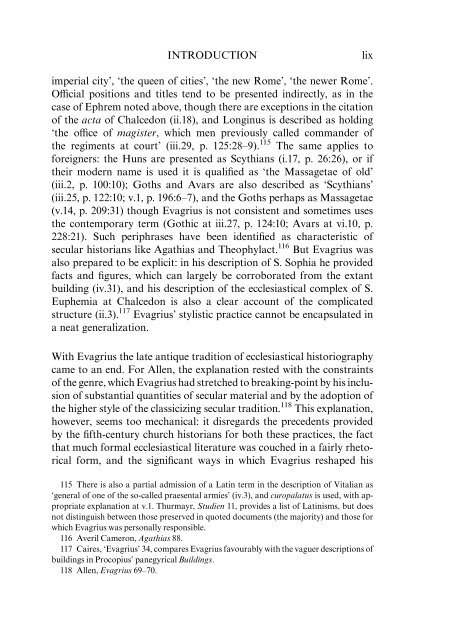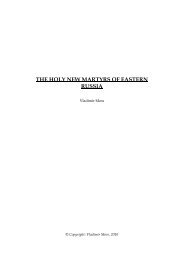- Page 2 and 3:
Translated Texts for Historians Thi
- Page 4 and 5:
Translated Texts for Historians Vol
- Page 6:
To Max, Brodie and Archie
- Page 9 and 10: viii EVAGRIUS TRANSLATION AND NOTES
- Page 11 and 12: ABBREVIATIONS AB = Analecta Bolland
- Page 14 and 15: INTRODUCTION BIOGRAPHICAL INFORMATI
- Page 16 and 17: INTRODUCTION xv property with good
- Page 18 and 19: INTRODUCTION xvii the revived festi
- Page 20 and 21: INTRODUCTION xix detect evidence fo
- Page 22 and 23: INTRODUCTION xxi possible that it h
- Page 24 and 25: INTRODUCTION xxiii Stylites the Eld
- Page 26 and 27: cedents to the Council of Constanti
- Page 28 and 29: have formed the basis of Eustathius
- Page 30 and 31: INTRODUCTION xxix description of th
- Page 32 and 33: eading of his source might have avo
- Page 34 and 35: INTRODUCTION xxxiii acta in the ear
- Page 36 and 37: INTRODUCTION xxxv life; and the pro
- Page 38 and 39: INTRODUCTION xxxvii Chalcedon as a
- Page 40 and 41: INTRODUCTION xxxix doctrinal matter
- Page 42 and 43: INTRODUCTION xli an explanation tha
- Page 44 and 45: INTRODUCTION xliii visited the shri
- Page 46 and 47: INTRODUCTION xlv incidental admissi
- Page 48 and 49: the Devil’s game, and so Evagrius
- Page 50 and 51: INTRODUCTION xlix word and deed and
- Page 52 and 53: unclear . . . since He knows both t
- Page 54 and 55: INTRODUCTION liii though it can be
- Page 56 and 57: INTRODUCTION lv long-winded to thos
- Page 58 and 59: INTRODUCTION lvii (ii.1: e.g. the d
- Page 62 and 63: INTRODUCTION lxi TEXT AND TRANSLATI
- Page 64: INTRODUCTION lxiii historical and h
- Page 67 and 68: 2 EVAGRIUS Synod was convened at Ep
- Page 69 and 70: 4 EVAGRIUS 15. Concerning the war a
- Page 71 and 72: 6 EVAGRIUS that nothing worthy of r
- Page 73 and 74: 8 EVAGRIUS contrived a variation ev
- Page 75 and 76: 10 EVAGRIUS bishopric, 20 at the ti
- Page 77 and 78: 12 EVAGRIUS which the life-giving S
- Page 79 and 80: 14 EVAGRIUS registered. 36 Theodotu
- Page 81 and 82: 16 EVAGRIUS they came to an agreeme
- Page 83 and 84: 18 EVAGRIUS we glori¢ed God the ma
- Page 85 and 86: 20 EVAGRIUS it is not named explici
- Page 87 and 88: 22 EVAGRIUS here in this way? 65 Or
- Page 89 and 90: 24 EVAGRIUS from Panopolis by barba
- Page 91 and 92: 26 EVAGRIUS bishop of Cyzicus, took
- Page 93 and 94: 28 EVAGRIUS assembled at Ephesus Ju
- Page 95 and 96: 30 EVAGRIUS inscrutable benevolence
- Page 97 and 98: 32 EVAGRIUS most irrational of all,
- Page 99 and 100: 34 EVAGRIUS 13 In these times too t
- Page 101 and 102: 36 EVAGRIUS he freed him to accompl
- Page 103 and 104: 38 EVAGRIUS Most of this man has be
- Page 105 and 106: 40 EVAGRIUS So, to the left-hand si
- Page 107 and 108: 42 EVAGRIUS 16 Then too the venerab
- Page 109 and 110: 44 EVAGRIUS and the unde¢led remai
- Page 111 and 112:
46 EVAGRIUS 19 In the same times of
- Page 113 and 114:
48 EVAGRIUS Of your race and blood
- Page 115 and 116:
50 EVAGRIUS di¡erent, but the orga
- Page 117 and 118:
52 EVAGRIUS and to clothe the body
- Page 120 and 121:
[34] THESE ARE THE CONTENTS OF THE
- Page 122 and 123:
ECCLESIASTICAL HISTORY: BOOK II 57
- Page 124 and 125:
ECCLESIASTICAL HISTORY: BOOK II 59
- Page 126 and 127:
ECCLESIASTICAL HISTORY: BOOK II 61
- Page 128 and 129:
ECCLESIASTICAL HISTORY: BOOK II 63
- Page 130 and 131:
ECCLESIASTICAL HISTORY: BOOK II 65
- Page 132 and 133:
ECCLESIASTICAL HISTORY: BOOK II 67
- Page 134 and 135:
ECCLESIASTICAL HISTORY: BOOK II 69
- Page 136 and 137:
ECCLESIASTICAL HISTORY: BOOK II 71
- Page 138 and 139:
ECCLESIASTICAL HISTORY: BOOK II 73
- Page 140 and 141:
ECCLESIASTICAL HISTORY: BOOK II 75
- Page 142 and 143:
ECCLESIASTICAL HISTORY: BOOK II 77
- Page 144 and 145:
ECCLESIASTICAL HISTORY: BOOK II 79
- Page 146 and 147:
ECCLESIASTICAL HISTORY: BOOK II 81
- Page 148 and 149:
ECCLESIASTICAL HISTORY: BOOK II 83
- Page 150 and 151:
ECCLESIASTICAL HISTORY: BOOK II 85
- Page 152 and 153:
een canonically deposed by Proteriu
- Page 154 and 155:
ECCLESIASTICAL HISTORY: BOOK II 89
- Page 156 and 157:
ECCLESIASTICAL HISTORY: BOOK II 91
- Page 158 and 159:
Now, master, it is timely to say:
- Page 160 and 161:
ECCLESIASTICAL HISTORY: BOOK II 95
- Page 162 and 163:
ECCLESIASTICAL HISTORY: BOOK II 97
- Page 164 and 165:
ECCLESIASTICAL HISTORY: BOOK II 99
- Page 166 and 167:
ECCLESIASTICAL HISTORY: BOOK II 101
- Page 168 and 169:
ECCLESIASTICAL HISTORY: BOOK II 103
- Page 170 and 171:
ECCLESIASTICAL HISTORY: BOOK II 105
- Page 172 and 173:
ECCLESIASTICAL HISTORY: BOOK II 107
- Page 174 and 175:
ECCLESIASTICAL HISTORY: BOOK II 109
- Page 176 and 177:
ECCLESIASTICAL HISTORY: BOOK II 111
- Page 178 and 179:
After these had been read, the whol
- Page 180 and 181:
which He derived from Her. As for t
- Page 182 and 183:
ECCLESIASTICAL HISTORY: BOOK II 117
- Page 184 and 185:
ECCLESIASTICAL HISTORY: BOOK II 119
- Page 186 and 187:
ECCLESIASTICAL HISTORY: BOOK II 121
- Page 188 and 189:
ECCLESIASTICAL HISTORY: BOOK II 123
- Page 190 and 191:
ECCLESIASTICAL HISTORY: BOOK II 125
- Page 192 and 193:
[94] THESE ARE THE CONTENTS OF THE
- Page 194 and 195:
ECCLESIASTICAL HISTORY: BOOK III 12
- Page 196 and 197:
ECCLESIASTICAL HISTORY: BOOK III 13
- Page 198 and 199:
ECCLESIASTICAL HISTORY: BOOK III 13
- Page 200 and 201:
ECCLESIASTICAL HISTORY: BOOK III 13
- Page 202 and 203:
ECCLESIASTICAL HISTORY: BOOK III 13
- Page 204 and 205:
ECCLESIASTICAL HISTORY: BOOK III 13
- Page 206 and 207:
ECCLESIASTICAL HISTORY: BOOK III 14
- Page 208 and 209:
to die, but he was murdered at the
- Page 210 and 211:
ECCLESIASTICAL HISTORY: BOOK III 14
- Page 212 and 213:
ECCLESIASTICAL HISTORY: BOOK III 14
- Page 214 and 215:
ECCLESIASTICAL HISTORY: BOOK III 14
- Page 216 and 217:
ECCLESIASTICAL HISTORY: BOOK III 15
- Page 218 and 219:
ECCLESIASTICAL HISTORY: BOOK III 15
- Page 220 and 221:
ECCLESIASTICAL HISTORY: BOOK III 15
- Page 222 and 223:
ECCLESIASTICAL HISTORY: BOOK III 15
- Page 224 and 225:
ECCLESIASTICAL HISTORY: BOOK III 15
- Page 226 and 227:
ECCLESIASTICAL HISTORY: BOOK III 16
- Page 228 and 229:
ECCLESIASTICAL HISTORY: BOOK III 16
- Page 230 and 231:
ECCLESIASTICAL HISTORY: BOOK III 16
- Page 232 and 233:
ECCLESIASTICAL HISTORY: BOOK III 16
- Page 234 and 235:
ECCLESIASTICAL HISTORY: BOOK III 16
- Page 236 and 237:
ECCLESIASTICAL HISTORY: BOOK III 17
- Page 238 and 239:
ECCLESIASTICAL HISTORY: BOOK III 17
- Page 240 and 241:
ECCLESIASTICAL HISTORY: BOOK III 17
- Page 242 and 243:
ECCLESIASTICAL HISTORY: BOOK III 17
- Page 244 and 245:
ECCLESIASTICAL HISTORY: BOOK III 17
- Page 246 and 247:
ECCLESIASTICAL HISTORY: BOOK III 18
- Page 248 and 249:
ECCLESIASTICAL HISTORY: BOOK III 18
- Page 250 and 251:
ECCLESIASTICAL HISTORY: BOOK III 18
- Page 252 and 253:
ECCLESIASTICAL HISTORY: BOOK III 18
- Page 254 and 255:
ECCLESIASTICAL HISTORY: BOOK III 18
- Page 256 and 257:
ECCLESIASTICAL HISTORY: BOOK III 19
- Page 258 and 259:
ECCLESIASTICAL HISTORY: BOOK III 19
- Page 260 and 261:
ECCLESIASTICAL HISTORY: BOOK III 19
- Page 262 and 263:
[148] THESE ARE THE CONTENTS OF THE
- Page 264 and 265:
ECCLESIASTICAL HISTORY: BOOK IV 199
- Page 266 and 267:
ECCLESIASTICAL HISTORY: BOOK IV 201
- Page 268 and 269:
ECCLESIASTICAL HISTORY: BOOK IV 203
- Page 270 and 271:
ECCLESIASTICAL HISTORY: BOOK IV 205
- Page 272 and 273:
ECCLESIASTICAL HISTORY: BOOK IV 207
- Page 274 and 275:
ECCLESIASTICAL HISTORY: BOOK IV 209
- Page 276 and 277:
ECCLESIASTICAL HISTORY: BOOK IV 211
- Page 278 and 279:
ECCLESIASTICAL HISTORY: BOOK IV 213
- Page 280 and 281:
ECCLESIASTICAL HISTORY: BOOK IV 215
- Page 282 and 283:
ECCLESIASTICAL HISTORY: BOOK IV 217
- Page 284 and 285:
ECCLESIASTICAL HISTORY: BOOK IV 219
- Page 286 and 287:
ECCLESIASTICAL HISTORY: BOOK IV 221
- Page 288 and 289:
ECCLESIASTICAL HISTORY: BOOK IV 223
- Page 290 and 291:
ECCLESIASTICAL HISTORY: BOOK IV 225
- Page 292 and 293:
ECCLESIASTICAL HISTORY: BOOK IV 227
- Page 294 and 295:
ECCLESIASTICAL HISTORY: BOOK IV 229
- Page 296 and 297:
ECCLESIASTICAL HISTORY: BOOK IV 231
- Page 298 and 299:
ECCLESIASTICAL HISTORY: BOOK IV 233
- Page 300 and 301:
ECCLESIASTICAL HISTORY: BOOK IV 235
- Page 302 and 303:
ECCLESIASTICAL HISTORY: BOOK IV 237
- Page 304 and 305:
ECCLESIASTICAL HISTORY: BOOK IV 239
- Page 306 and 307:
ECCLESIASTICAL HISTORY: BOOK IV 241
- Page 308 and 309:
ECCLESIASTICAL HISTORY: BOOK IV 243
- Page 310 and 311:
ECCLESIASTICAL HISTORY: BOOK IV 245
- Page 312 and 313:
and the so-called letter of Ibas to
- Page 314 and 315:
And a bit later: ECCLESIASTICAL HIS
- Page 316 and 317:
ECCLESIASTICAL HISTORY: BOOK IV 251
- Page 318 and 319:
[193] THESE ARE THE CONTENTS OF THE
- Page 320 and 321:
ECCLESIASTICAL HISTORY: BOOK V 255
- Page 322 and 323:
ECCLESIASTICAL HISTORY: BOOK V 257
- Page 324 and 325:
ECCLESIASTICAL HISTORY: BOOK V 259
- Page 326 and 327:
ECCLESIASTICAL HISTORY: BOOK V 261
- Page 328 and 329:
ECCLESIASTICAL HISTORY: BOOK V 263
- Page 330 and 331:
ECCLESIASTICAL HISTORY: BOOK V 265
- Page 332 and 333:
ECCLESIASTICAL HISTORY: BOOK V 267
- Page 334 and 335:
ECCLESIASTICAL HISTORY: BOOK V 269
- Page 336 and 337:
ECCLESIASTICAL HISTORY: BOOK V 271
- Page 338 and 339:
ECCLESIASTICAL HISTORY: BOOK V 273
- Page 340 and 341:
ECCLESIASTICAL HISTORY: BOOK V 275
- Page 342 and 343:
ECCLESIASTICAL HISTORY: BOOK V 277
- Page 344 and 345:
ECCLESIASTICAL HISTORY: BOOK V 279
- Page 346 and 347:
ECCLESIASTICAL HISTORY: BOOK V 281
- Page 348 and 349:
ECCLESIASTICAL HISTORY: BOOK V 283
- Page 350 and 351:
ECCLESIASTICAL HISTORY: BOOK V 285
- Page 352 and 353:
ECCLESIASTICAL HISTORY: BOOK V 287
- Page 354 and 355:
[220] THESE ARE THE CONTENTS OF THE
- Page 356 and 357:
ECCLESIASTICAL HISTORY: BOOK VI 291
- Page 358 and 359:
ECCLESIASTICAL HISTORY: BOOK VI 293
- Page 360 and 361:
ECCLESIASTICAL HISTORY: BOOK VI 295
- Page 362 and 363:
ECCLESIASTICAL HISTORY: BOOK VI 297
- Page 364 and 365:
ECCLESIASTICAL HISTORY: BOOK VI 299
- Page 366 and 367:
ECCLESIASTICAL HISTORY: BOOK VI 301
- Page 368 and 369:
ECCLESIASTICAL HISTORY: BOOK VI 303
- Page 370 and 371:
ECCLESIASTICAL HISTORY: BOOK VI 305
- Page 372 and 373:
ECCLESIASTICAL HISTORY: BOOK VI 307
- Page 374 and 375:
ECCLESIASTICAL HISTORY: BOOK VI 309
- Page 376 and 377:
ECCLESIASTICAL HISTORY: BOOK VI 311
- Page 378 and 379:
ECCLESIASTICAL HISTORY: BOOK VI 313
- Page 380 and 381:
ECCLESIASTICAL HISTORY: BOOK VI 315
- Page 382:
ECCLESIASTICAL HISTORY: BOOK VI 317
- Page 385 and 386:
320 APPENDIX I John II 496^505 John
- Page 388 and 389:
APPENDIX II THE IMAGE OF EDESSA Alt
- Page 390 and 391:
THE IMAGE OF EDESSA 325 Procopius o
- Page 392 and 393:
GLOSSARY Acacian Schism. The disput
- Page 394 and 395:
GLOSSARY 329 hypostasis. Literally
- Page 396:
GLOSSARY 331 edict of 534, the here
- Page 399 and 400:
334 BIBLIOGRAPHY Chron. ad an. 1234
- Page 401 and 402:
336 BIBLIOGRAPHY öö, Discours 38^
- Page 403 and 404:
338 BIBLIOGRAPHY Malalas, Chronicle
- Page 405 and 406:
340 BIBLIOGRAPHY Slavonic Malalas;
- Page 407 and 408:
342 BIBLIOGRAPHY W. D. Barry, ‘Ar
- Page 409 and 410:
344 BIBLIOGRAPHY G. F. Chesnut, The
- Page 411 and 412:
346 BIBLIOGRAPHY E. K. Fowden, The
- Page 413 and 414:
348 BIBLIOGRAPHY E. Je¡reys (ed.),
- Page 415 and 416:
350 BIBLIOGRAPHY öö, The Prosopog
- Page 417 and 418:
352 BIBLIOGRAPHY eschatological ele
- Page 420:
MAPS
- Page 423 and 424:
The Middle East
- Page 425 and 426:
Constantinople
- Page 427 and 428:
362 Tetrapylon 85^6 Tychaeum 42 foo
- Page 429 and 430:
364 Ardabur (grandson) 36^7 Areobin
- Page 431 and 432:
366 154^5, 157^9, 162,166^7, 171^ 2
- Page 433 and 434:
368 Dexippus 286 Didymus the Blind
- Page 435 and 436:
370 Fausta, wife of Constantine 186
- Page 437 and 438:
372 Jerusalem, xviii, 36, 48^9, 75,
- Page 439 and 440:
374 Licinius, emperor 189 Limnae 14
- Page 441 and 442:
376 Numan, Lakhmid (590s) 314 Numid
- Page 443 and 444:
378 Rhodope 57 Ricimer 83^4, 99 Rom
- Page 445 and 446:
380 Thecla xix, 142 Theia (Teias) 2
- Page 447 and 448:
382 Yarmuk xliii Yazdgard I 46 Yazd
- Page 449 and 450:
384 Chronicon ad an.1234, cited 266
- Page 451 and 452:
386 sources: documents xxii^xxiii,
- Page 453 and 454:
388 Monophysites xix^xx, xxxvii, xl
- Page 455:
390 Sozomen xx, xliii, lv, lx^lxi,




